Have you ever wondered what happens when Louisiana’s beloved jambalaya meets pasta? Furthermore, what if I told you this fusion creates one of the most satisfying, budget-friendly meals you can make? Today, we’re diving deep into the world of Pastalaya Recipe – a dish that perfectly captures the soul of Cajun cooking while remaining incredibly accessible to home cooks everywhere.
Table of Content
- What is Pastalaya? Understanding This Louisiana Treasure
- Every Pastalaya Recipe Tells a Different Story
- Essential Ingredients for Authentic Louisiana Pastalaya Recipe
- One Pot Pastalaya: Step-by-Step Instructions
- Pro Tips for Perfect Pastalaya Every Time
- Nutritional Benefits and Serving Suggestions
- Making It Your Own: Variations and Adaptations
- Frequently Asked Questions
- Other Rcipe
- Recipe Card

What is Pastalaya? Understanding This Louisiana Treasure
First and foremost, let’s clarify what pastalaya actually is. Simply put, pastalaya is essentially jambalaya’s pasta-loving cousin. Instead of using traditional rice, this hearty dish swaps in pasta to create an equally delicious and satisfying meal. Moreover, this substitution makes the dish more familiar to those who might be intimidated by traditional Cajun rice dishes.
Additionally, pastalaya has deep roots in Louisiana culture, particularly in New Orleans and throughout the state. You’ll often find this dish gracing tables at large gatherings, celebrations, and especially during Mardi Gras festivities. Consequently, it has become a staple for feeding crowds without breaking the bank.
What makes this budget friendly pastalaya particularly appealing is its incredible value proposition. Not only does it feed a large number of people, but it also delivers maximum flavor with minimal investment. Therefore, it’s perfect for families looking to stretch their grocery budget while still enjoying restaurant-quality taste.
Every Pastalaya Recipe Tells a Different Story
Interestingly, much like jambalaya, there’s no single “correct” way to make pastalaya recipe variations. Instead, each family, restaurant, and region has developed their own unique approach to this beloved dish. However, the version we’re sharing today represents a wonderful starting point that captures the essence of traditional Louisiana flavors.
Our particular pastalaya recipe features smoky andouille sausage, the holy trinity of Cajun vegetables, aromatic herbs, and a touch of cream for richness. Nevertheless, many cooks love to add their own personal touches. For instance, some prefer to include chicken for extra protein, while others incorporate shrimp for a seafood twist. Ultimately, these variations demonstrate the dish’s incredible versatility.
Furthermore, the beauty of pastalaya recipes lies in their adaptability. Whether you’re cooking for a small family dinner or a large gathering, you can easily adjust the quantities while maintaining the dish’s signature flavors and textures.
Essential Ingredients for Authentic Louisiana Pastalaya Recipe
The Sausage Foundation
First and foremost, the sausage serves as the flavor backbone of any louisiana pastalaya recipe. Traditionally, andouille sausage is the gold standard, bringing its distinctive smoky, spicy character to the dish. However, if andouille isn’t available in your area, any high-quality smoked sausage will work wonderfully as a substitute.
The Holy Trinity: Cajun’s Secret Weapon
Next, we need to discuss the “trinity” – the aromatic vegetable base that forms the foundation of virtually all Cajun and Creole cooking. This magical combination consists of onions, green bell peppers, and celery in equal proportions. Together, these vegetables create a flavor profile that’s both complex and comforting.
Additionally, you have options when it comes to preparation. For convenience, many grocery stores now sell pre-chopped frozen seasoning mix that includes the trinity. Alternatively, you can certainly use fresh vegetables, which often provide superior texture and flavor.
Supporting Cast of Flavors
Beyond the sausage and trinity, several other ingredients play crucial roles in creating an authentic pastalaya recipe cajun experience. Fresh garlic adds pungency, while diced tomatoes contribute acidity and sweetness. Meanwhile, Creole seasoning blend brings the distinctive spice profile that makes this dish sing.
Herbs also play a vital role in the flavor development. Oregano provides earthiness, smoked paprika adds depth, thyme contributes floral notes, and black pepper brings heat. Furthermore, chicken broth serves as the cooking liquid, infusing every grain of pasta with savory goodness.
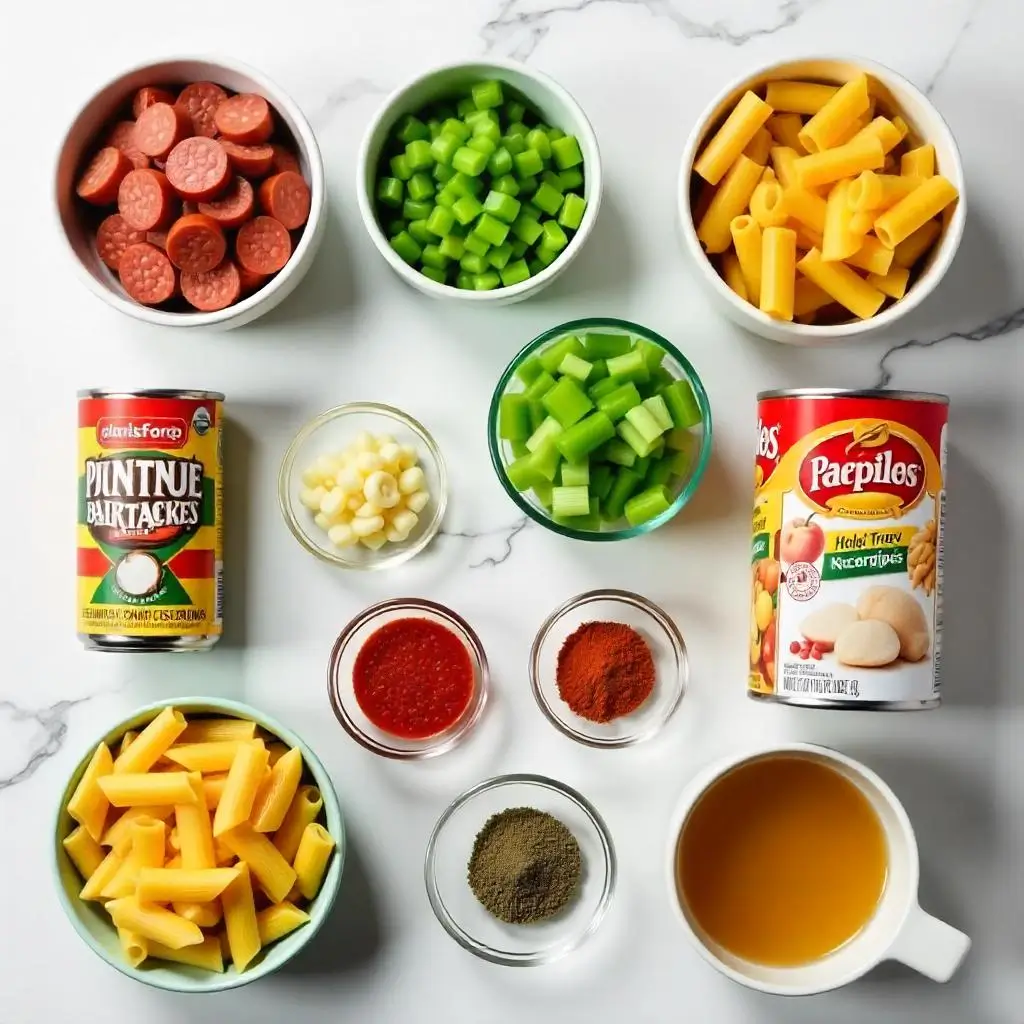
One Pot Pastalaya: Step-by-Step Instructions
Getting Started: The Foundation
To begin, heat a large, heavy-bottomed pot or Dutch oven over medium-high heat. First, add the sliced andouille sausage and cook until it develops a beautiful golden-brown color on both sides. This browning process is crucial because it creates fond – those flavorful brown bits that will enhance the entire dish.
Subsequently, remove the sausage and set it aside, but leave the rendered fat in the pot. This flavorful fat will serve as the cooking medium for our vegetables, ensuring every component is infused with smoky sausage flavor.
Building the Flavor Base
Next, add the diced onions, bell peppers, and celery to the pot. Cook these vegetables until they begin to soften and become fragrant, typically about 5-7 minutes. Then, add the minced garlic and cook for an additional minute, being careful not to let it burn.
At this point, the kitchen should be filled with an incredible aroma that promises great things to come. The vegetables should be tender but still have some texture, providing the perfect foundation for the remaining ingredients.
Bringing It All Together
Now, it’s time to add the diced tomatoes, Creole seasoning, and herbs to the pot. Stir everything together and let it cook for about 2 minutes, allowing the flavors to meld and the tomatoes to release their juices.
Following this, pour in the chicken broth and water, then bring the mixture to a rolling boil. Once boiling, add the pasta and return the browned sausage to the pot. Stir everything well to ensure even distribution.
The Cooking Process
Reduce the heat to medium-low and let the mixture simmer, stirring occasionally to prevent sticking. The pasta will absorb most of the liquid as it cooks, typically taking about 12-15 minutes depending on the pasta shape you’ve chosen.
During this time, taste and adjust the seasoning as needed. Remember, the flavor will continue to develop as the dish cooks, so don’t over-season early in the process.
Final Touches
Once the pasta is tender and most of the liquid has been absorbed, stir in the heavy cream and chopped fresh herbs. The cream adds richness and helps bind all the flavors together, while the fresh herbs provide a bright, aromatic finish.
Finally, remove the pot from heat and let it rest for about 5 minutes before serving. This resting period allows the flavors to settle and any remaining liquid to be fully absorbed.
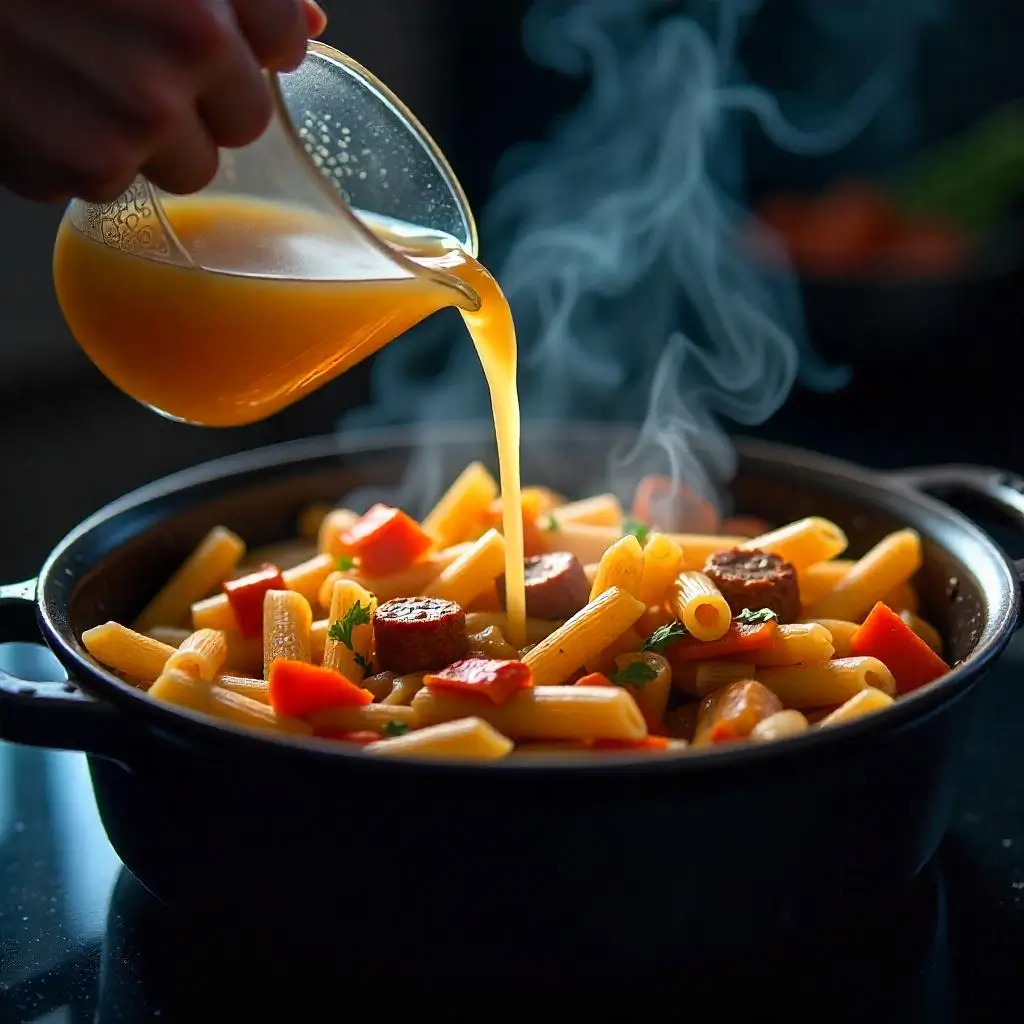
Pro Tips for Perfect Pastalaya Every Time
Choosing the Right Pasta
While penne pasta works beautifully in this recipe, you can experiment with other shapes. However, choose pasta that will hold up well during the cooking process and capture the sauce effectively. Shells, rigatoni, or rotini all make excellent alternatives.
Managing the Liquid
Furthermore, pay close attention to the liquid levels during cooking. If the pasta seems to be absorbing liquid too quickly, add a bit more broth or water. Conversely, if there’s too much liquid at the end, continue cooking uncovered until it reduces to your desired consistency.
Seasoning Considerations
Moreover, remember that Creole seasoning blends can vary significantly in salt content. Therefore, taste before adding additional salt, and adjust gradually to avoid over-seasoning.
Nutritional Benefits and Serving Suggestions
This one pot pastalaya provides a well-balanced meal with protein from the sausage, carbohydrates from the pasta, and vegetables from the trinity. Additionally, the dish contains important nutrients like vitamin C from the bell peppers and fiber from the vegetables and pasta.
For serving, consider pairing this hearty dish with a simple green salad or some crusty French bread. The acidity of a light salad helps balance the richness of the pastalaya, while bread is perfect for sopping up any remaining sauce.
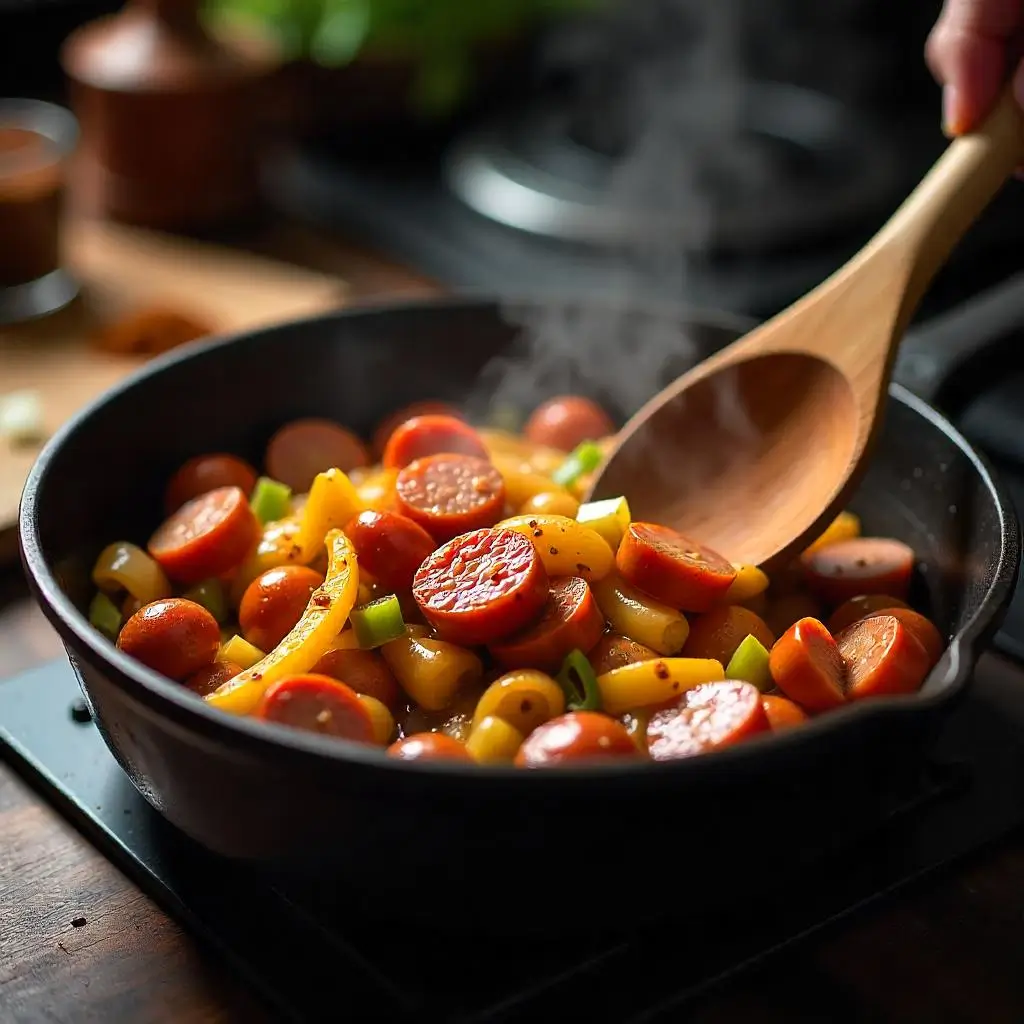
Making It Your Own: Variations and Adaptations
As mentioned earlier, pastalaya recipes are incredibly adaptable. For instance, you might add diced chicken breast for extra protein, or incorporate shrimp during the last few minutes of cooking for a seafood twist. Similarly, some cooks prefer to blend their trinity vegetables for a smoother texture, while others like to keep them chunky for more bite.
Additionally, the cream component can be adjusted based on your preferences. Some cooks prefer a brothier consistency and omit the cream entirely, while others double the amount for an extra-rich finish.
Frequently Asked Questions
Can I make this ahead of time?
Yes! However, add the cream when reheating to prevent separation.
What if I can’t find andouille sausage?
Any smoked sausage works well – kielbasa, chorizo, or even Italian sausage.
How do I prevent the pasta from getting mushy?
Cook just until al dente and let residual heat finish the cooking process.
Can I double this recipe?
Absolutely! Use a larger pot and increase cooking time by 5-10 minutes.
Nutrition Information (per serving, based on 8 servings)
- Calories: 385
- Protein: 18g
- Carbohydrates: 42g
- Fat: 16g
- Fiber: 3g
- Sodium: 890mg
- Cholesterol: 45mg
Other Rcipe
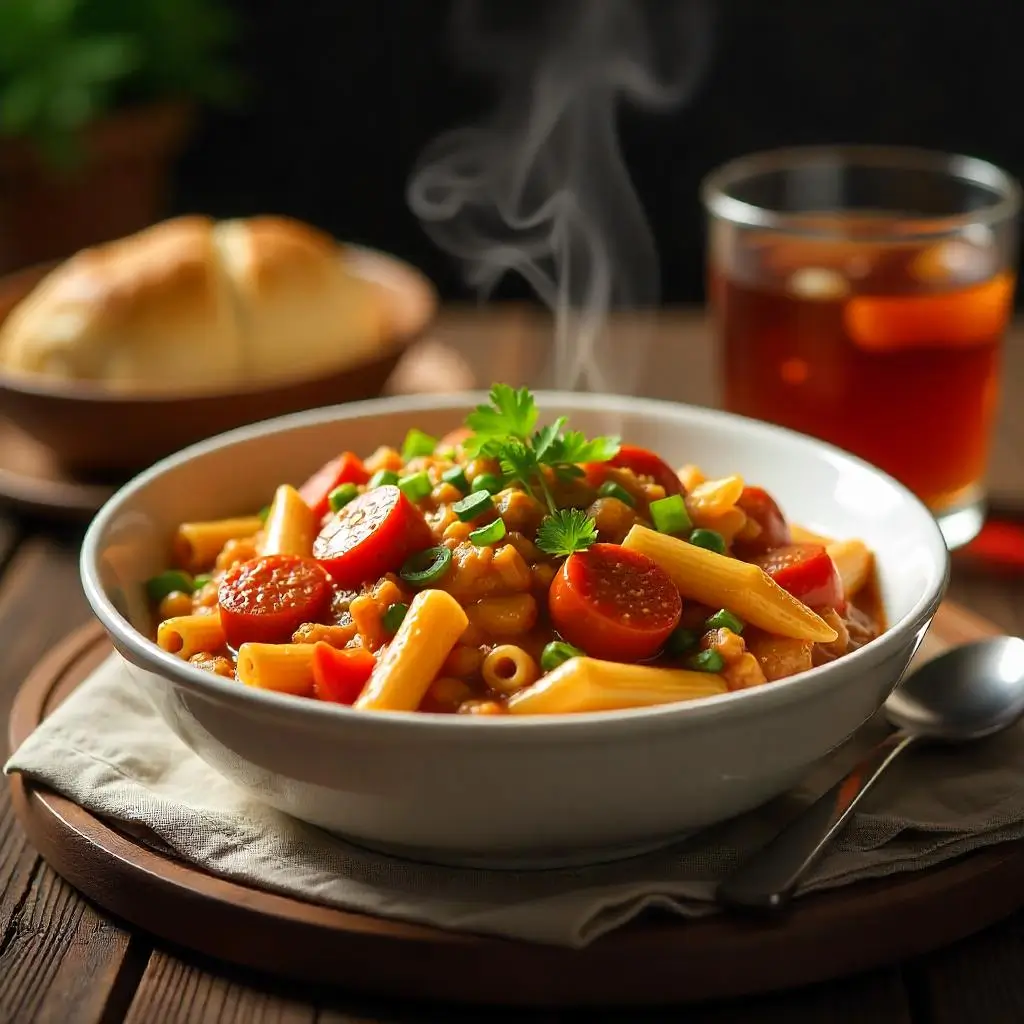
In conclusion, this budget friendly pastalaya represents everything we love about Louisiana cooking: bold flavors, simple techniques, and ingredients that won’t strain your wallet. Moreover, the one-pot cooking method makes cleanup a breeze, which is always a welcome bonus on busy weeknights.
Whether you’re new to Cajun cooking or a seasoned pro looking for a fresh take on classic flavors, this pastalaya recipe delivers satisfaction in every bite. Furthermore, its crowd-pleasing nature makes it perfect for everything from family dinners to potluck gatherings.
So why not give this louisiana pastalaya recipe a try? With its combination of smoky sausage, perfectly seasoned vegetables, and tender pasta, it’s sure to become a regular rotation in your meal planning. After all, few dishes can claim to be both budget-friendly and restaurant-quality, but this one pot pastalaya certainly fits the bill.
Recipe Card
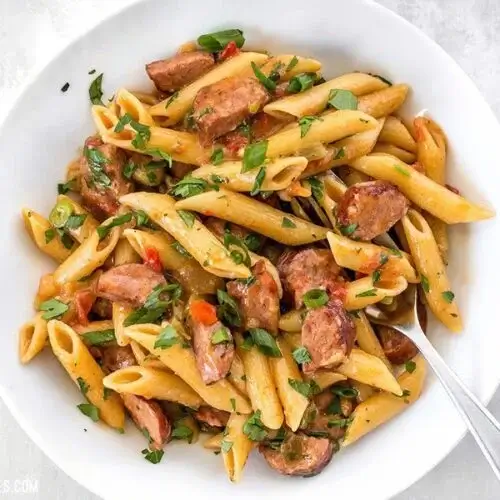
“How to Make the Best Pastalaya Recipe at Home”
Description
Easy One Pot Pastalaya recipe with andouille sausage & Cajun spices. Budget-friendly Louisiana comfort food ready in 30 minutes. Perfect for families!
Ingredients
Proteins & Main Components
The Holy Trinity Base
Flavor Builders
Liquids
Fresh Finishing Touches
Instructions
- Heat a large Dutch oven or heavy-bottomed pot over medium-high heat
- Add sliced andouille sausage in a single layer
- Cook for 2-3 minutes per side until golden brown and crispy
- Remove sausage to a plate, leaving the rendered fat in the pot
- 💡 Pro Tip: Don’t overcrowd the pan – brown in batches if necessary
- Add diced onions, bell peppers, and celery to the same pot
- Cook for 5-6 minutes, stirring occasionally, until vegetables begin to soften
- Add minced garlic and cook for 1 more minute until fragrant
- Season with a pinch of salt and pepper
- 💡 Pro Tip: The vegetables should still have some texture – don’t overcook
- Stir in drained diced tomatoes, Creole seasoning, oregano, smoked paprika, thyme, and black pepper
- Cook for 2 minutes, stirring constantly to toast the spices
- The mixture should be very fragrant at this point
- Pour in chicken broth and water, then bring to a rolling boil
- Add the pasta and return the browned sausage to the pot
- Stir well to combine and ensure pasta is submerged
- Reduce heat to medium-low and simmer for 12-15 minutes, stirring every 3-4 minutes
- 💡 Pro Tip: Stir regularly to prevent sticking, but don’t over-stir as this can break the pasta
- Once pasta is tender and most liquid is absorbed, remove from heat
- Stir in heavy cream until well combined
- Add chopped parsley and sliced green onions
- Taste and adjust seasoning with salt, pepper, or additional Creole seasoning
- Let rest for 5 minutes before serving
Step 1: Brown the Sausage (5 minutes)
Step 2: Build the Flavor Base (8 minutes)
Step 3: Add Aromatics (2 minutes)
Step 4: Add Liquids and Pasta (15 minutes)
Step 5: Final Assembly (3 minutes)
Notes
- Main dish: Serve with crusty French bread and a simple green salad
Side additions: Hot sauce, extra green onions, or grated Parmesan cheese
Beverage pairings: Sweet tea, beer, or a light white wine